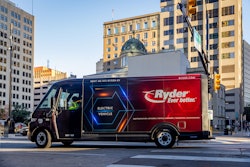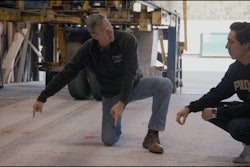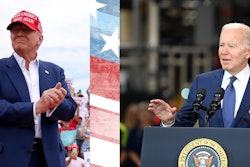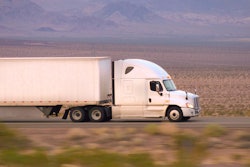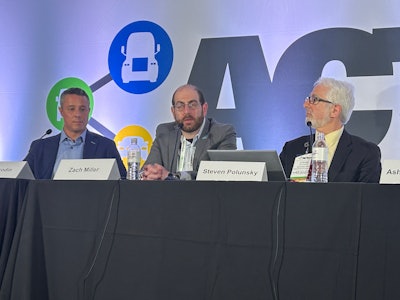
California’s clean air regulations have spread to 15 other states and, while a handful of other states have outright banned zero-emission mandates, it’s clear that The Golden State is setting the pace for zero-emission truck regulations that eventually will make its way coast-to-coast in some form.
“Our rules in California are changing the country. Unlike Vegas, what happens in California does not stay in California,” GNA Vice President of Regulatory Compliance Rebecca Schenker said during a regulatory workshop the Advanced Clean Transportation (ACT) Expo in Las Vegas Monday. “Regardless of lawsuits, you can see the trends. We have got to figure this out.”
Clean air isn’t a state-specific issue and Steven Polunsky, Washington State Department of Commerce’s senior energy policy specialist for clean transportation, likened the removal of fossil fuels from trucking to the ban of lead-based paint and asbestos: both commonly accepted until their adverse effect on public health were discovered. He added that carbon-based fuels are, too, a public health concern.
Polunsky, however, did concede that emissions have become a partisan political issue, and that is what drove states – specifically California – to wrest control of air quality mandates.
The Clean Air Act (CAA) of 1970 grants California the right to set it's own emission standards, a right not given to any other state, however, Section 177 of the Clean Air Act authorizes states to adopt California’s standards in lieu of federal requirements. There are currently 12 Section 177 states: Connecticut, Delaware, Maine, Maryland, Massachusetts, New Jersey, New York, Oregon, Pennsylvania, Rhode Island, Vermont and Washington. Some of those states have already adopted California's Advanced Clean Trucks (ACT) and some have not.
"This patchwork is a nightmare to deal with," said Josh Grodin, Penske’s vice president of government affairs.
A lack of regulatory harmony is not only frustrating for fleets. State-level stakeholders don't care for it either.
“Emissions don’t respect state borders. Emissions travel,” said Zach Miller, director of metro region operations for the Trucking Association of New York. “It’s really important that is federally monitored because state-by-state is a problem. Even in the (New York/New Jersey) corridor, there’s conflict of what the rule is going to look like, which causes massive problems with how they will comply.”
With all eyes on California, and with many other states following its lead, the pressure is on for California lawmakers to deliver meaningful results that don't come at the expense of business casualties for the state's motor carriers.
"They’ve got to get it right," Grodin said of California's Air Resources Board (CARB). "California is going to decarbonize. That is a fact. How do they do it in a way that is realistic and makes sense? There needs to be a federal standard (to eliminate the patchwork)."
Eliminating the patchwork
Polunsky said there have been "several" multi-state agreements struck between Washington and Oregon and Washington and California, and Miller said "there is dialogue" among Section 177 states to try and harmonize efforts, "but the politics of this, you cannot overlook. Even in the states that have similar political leanings.”
Miller said there is some good collaboration among New York regional ports, “but New York in many ways sort of wants to be the leader,” he said. “In general, I don’t think they’re on the same page yet.”
Impact on business
Electric trucks are expensive and in many cases, total cost of ownership (TCO) comparisons don't make a zero-emission conversion viable. Grodin noted that it takes three EVs to do the job of a single diesel semi.
"(TCO) is not even close," he said. "The future is to be determined, but in 2024 (TCO) is way off.”
Polunsky said “literally millions of dollars” have been made available in subsidies in Washington to advance emission reduction and relieve some of the financial burden. “We are stepping up and providing technical assistance for grant writing," he added.
Those state and federal backed dollars are going to be critical for equipment acquisition.
“Incentives are going to make this happen. The issue becomes about who is able to deploy this technology: it’s the larger fleets,” said Harbor Trucking Association CEO Matt Schrap, adding he’s never seen a total cost of ownership analysis work where subsidies weren’t used. “That’s how we do this: money. We need more money.”
Miller said New York has incentives for clean trucks but “the state itself is playing catch up. The utilities unfortunately were a little bit behind,” he said, adding there are now subsidies available for facility updates.
The heavy regulatory burden, Miller conceded, has chased some business from the state, leading to adverse air quality consequences.
“We have some dealers that are actually opening up locations outside of the state,” he said. “It means that we’re not making as many cleaner diesel sales. We're looking at a scenario that instead of cleaning our fleets, we are looking at dirtier trucks on the road.”
Fleets, too, are seeking refuge outside of ACT states. "You hear fleets say that’s what they’re going to do," Miller said, adding that geography has gotten more consideration when it comes to mergers and acquisition, but “demand is demand. Someone is going to meet that freight demand.”
“You might not see a business come completely out of a market," Grobin added, "but you will see de-fleeting. That’s just going to happen.”
Washington and New York have tried to take a more fuel- and technology-agnostic approach with the hopes of driving adoption of greener solutions in the segments where they make the most sense.
“You can put in all the regulations you want, but if (a fleet) can't finance a vehicle… or the utility can’t charge… it’s not going to work," Miller said. "We have to meet this 2050 (zero emission) deadline, but there’s a reasonable way to do it and an unreasonable way to do it.”
California's Advanced Clean Fleets rule is under heavy legal fire and, so far, many Section 177 states have not considered adopting it. Grodin said that gives fleets and trucking stakeholders a stronger voice in finding a workable middle ground.
"If you take the political pressure that is on everybody in the state of California to make sure the ACF doesn’t crash and burn… there is an opportunity to come up with a solution… an opportunity for all of us to get together so we can pass smart decarbonization regulation that has a chance at succeeding.”
Like the lead paint and asbestos bans, Miller said current and future legislative reforms are going to be a work in progress.
“We’re all learning and growing together, and it’s okay for this legislation to do that, too,” Miller said.






